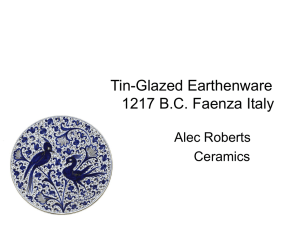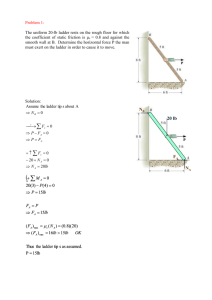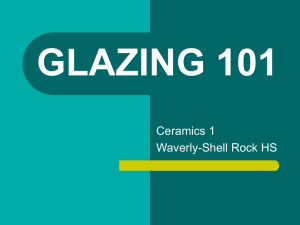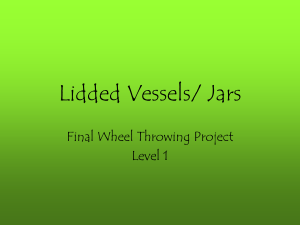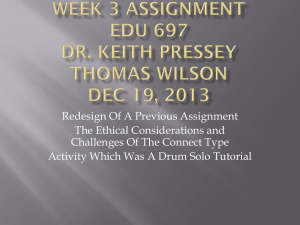Glaze And Clay Water Management - Fhda.edu
advertisement
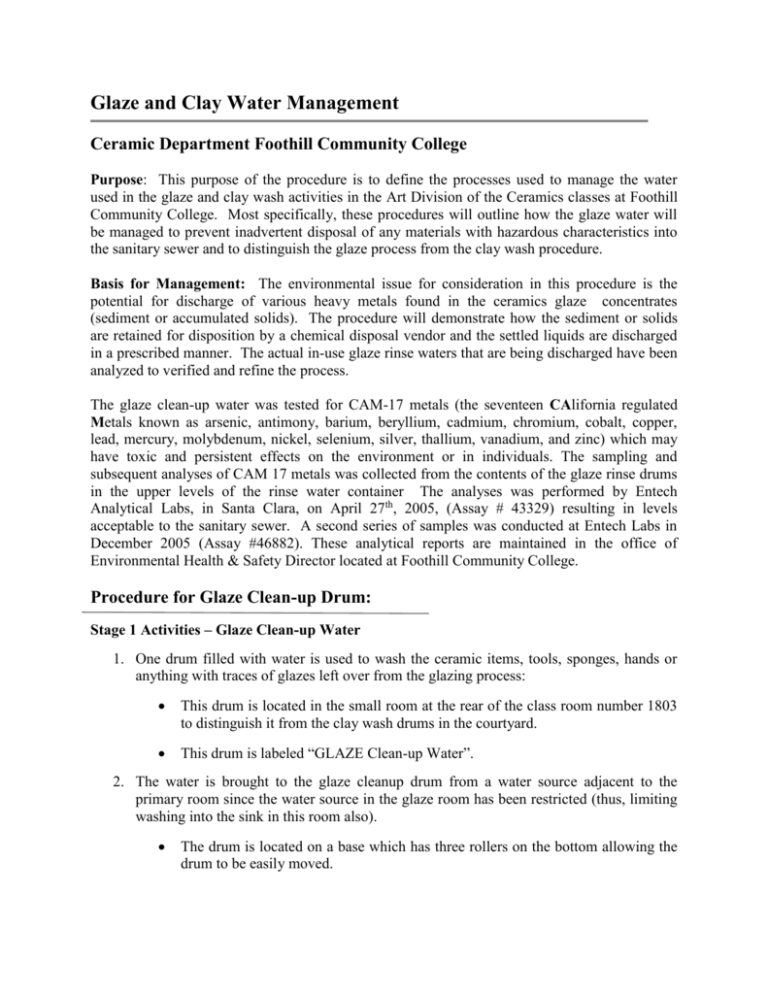
Glaze and Clay Water Management Ceramic Department Foothill Community College Purpose: This purpose of the procedure is to define the processes used to manage the water used in the glaze and clay wash activities in the Art Division of the Ceramics classes at Foothill Community College. Most specifically, these procedures will outline how the glaze water will be managed to prevent inadvertent disposal of any materials with hazardous characteristics into the sanitary sewer and to distinguish the glaze process from the clay wash procedure. Basis for Management: The environmental issue for consideration in this procedure is the potential for discharge of various heavy metals found in the ceramics glaze concentrates (sediment or accumulated solids). The procedure will demonstrate how the sediment or solids are retained for disposition by a chemical disposal vendor and the settled liquids are discharged in a prescribed manner. The actual in-use glaze rinse waters that are being discharged have been analyzed to verified and refine the process. The glaze clean-up water was tested for CAM-17 metals (the seventeen CAlifornia regulated Metals known as arsenic, antimony, barium, beryllium, cadmium, chromium, cobalt, copper, lead, mercury, molybdenum, nickel, selenium, silver, thallium, vanadium, and zinc) which may have toxic and persistent effects on the environment or in individuals. The sampling and subsequent analyses of CAM 17 metals was collected from the contents of the glaze rinse drums in the upper levels of the rinse water container The analyses was performed by Entech Analytical Labs, in Santa Clara, on April 27th, 2005, (Assay # 43329) resulting in levels acceptable to the sanitary sewer. A second series of samples was conducted at Entech Labs in December 2005 (Assay #46882). These analytical reports are maintained in the office of Environmental Health & Safety Director located at Foothill Community College. Procedure for Glaze Clean-up Drum: Stage 1 Activities – Glaze Clean-up Water 1. One drum filled with water is used to wash the ceramic items, tools, sponges, hands or anything with traces of glazes left over from the glazing process: This drum is located in the small room at the rear of the class room number 1803 to distinguish it from the clay wash drums in the courtyard. This drum is labeled “GLAZE Clean-up Water”. 2. The water is brought to the glaze cleanup drum from a water source adjacent to the primary room since the water source in the glaze room has been restricted (thus, limiting washing into the sink in this room also). The drum is located on a base which has three rollers on the bottom allowing the drum to be easily moved. Stage 2 Activities - Settling Drum 1. Every two weeks the ceramic technician moves the GLAZE Clean-up drum to the courtyard where an empty drum is staged upon a secondary containment pallet. 2. Prior to moving the GLAZE Clean-up drum, the appropriate lid is placed on the GLAZE Clean-up drum. 3. In addition, the two “PIG drain covers are placed over the small sanitary sewer drain and larger French drain located in the Ceramics courtyard area also prior to moving the GLAZE Clean-up drum. The drain covers will remain in place until after the GLAZE Clean-up drum is moved back into the dry, glaze storage room. 4. The technician carefully withdraws (scoops out the water and the sediment with a plastic pitcher) into the drum that will be used for the settling of solids and sediment. The empty GLAZE Clean-up drum is returned to the collection area in the small glaze room. 5. This drum is labeled “Settling Drum” and will remain undisturbed for a minimum of 6 days. This period of time allows the glaze rinse waters to have settled particulates for the maximum precipitation of the solids to the bottom of the drum. 6. At the end of this time, the liquids are carefully pumped from atop of the solids without unsettling the sediment or solids so that the solids remain totally undisturbed and only the clear liquid is removed. This clear/clean liquid is emptied into the sink. The previous analytical waste determinations have already proved that this liquid qualifies for drain disposal. 7. Then, the technician removes the suspended sediment from the bottom of the settling drum and places it into Department of Transportation (DOT) shippable drum that will become the collection vessel for the sediment / solids from the settling drum. 8. The lid is then secured on the GLAZE Clean-up drum and the drum is moved back to the dry, glaze storage room. The two “PIG drain covers” may then be removed from the sanitary sewer and French drains. The Director of Risk Management has not granted permission for the covers to remain in place on an ongoing basis since the drains are in a direct “traffic” flow and the trip hazard is great. 9. The management of the Stage 2 - Settling Drum progresses continues regularly throughout the quarter with sediment being transferred into the Waste Disposal Drum. Stage 3 Activities – Waste Disposal Drum 1. This 55 gallon Waste Drum becomes the accumulation source for the sediment containing the glaze resides. It is labeled with the accumulation start date reflecting the time where the first residue was placed into the drum. This Waste Drum is located in the ceramics courtyard on a secondary containment pallet adjacent to the Stage 2 - Settling Drum. 2. The technician continues to add sediment to the Waste Drum from the Stage 2 - Settling Drum throughout the quarter. The technician follows this process until the waste drum is full of solids. The drum is labeled as a Hazardous Waste Liquid with this detail – Hazardous Waste Liquid, N.O.S. 9 NA3082 Packing Group III. 3. The drum will be removed either: when it is full – in the event the class volume produces a full drum before the regulatory disposal date, or No later than 90 days of the accumulation start date. 4. Every two weeks, the Chemical Waste Disposal Team (Romic Environmental Services) checks the status of the drum with the glaze solids and liquids. They evaluate the drum for integrity, assure the label is intact, remove the drum if the drum is full or remove the drum if the drum has had any waste contents approaching 90 day maximum storage time. 5. When the vendor remove the Waste Drum, they replace the drum with another DOT shippable drum and places a Hazardous Waste label on the drum reflecting the description of the waste. 6. Full drums are removed by a dolly to the chemical waste disposal truck licensed by DOT for transport. The chemical waste disposal technicians manifest this material to the final disposal facility licensed by the Department of Toxic Substances Control (DTSC) in the State of California. Procedure for Glaze Spill, Residue and Floor Clean-up: 1. During the active process of mixing, distributing or applying glazes, glaze powders or solutions may drip or spill onto the floor or work areas. 2. On a routine basis for preventative maintenance or on a “as need basis”, the laboratory technician mops the floor with a mop and bucket dedicated to the glaze room. He then empties the glaze wash waster into the GLAZE Cleanup drum, providing additional liquids and trace glaze sediment to the drum. 3. The wash liquids settle depositing the glaze residues with the residues for the existing process. The water rises to the top of the drum where it commingles with the other waters becoming part of the previously defined procedure. Procedure for Clay Clean-up Drums: 1. As students begin the initial process of making ceramic art objects, they utilize tools, buckets, scraping tools, sponges, wheels, “bats”, boards and their hands in working with the clay. All of these come in contact with the clay and have clay buildup or residues on them. The larger quantities of accumulated clay is scraped from the items and placed in a trash receptacle. Clay residues are washed from all articles and the hands. 2. In order to wash the clay from these items, including the student’s hands, three drums have been set up in a row in the ceramic department’s courtyard labeled CLAY Clean-up Water. Three drums are necessary to accommodate the class size so that students may work around the drums at the same time. All drums are exactly the same with water for clay residue washing. Each drum has a faucet to supply water and an overflow drain that leads to the floor cup sink. This floor cup sink is a white porcelain unit about 1.5 feet by 0.5 feet which collects water and then discharges into the sewer. These drums are labeled “CLAY Clean-up Water”. 3. Through the course of the classes each quarter, students use these drums for washing, adding water to the drum during the washing process. The water level in the drum elevates with the excess clear/clean water draining off of the drum from the overflow valve at the very top of the drum. 4. The clay residue continues to drop to the bottom of the drum during the quarter duration. The drum sludge is removed on a quarterly basis by the non-hazardous sanitary waste disposal vendor (septic pumping contractor) who pumps the entire contents from the drums. This material is disposed of as a non-hazardous material. 5. Please take note of the following: Clay is a non-hazardous inert material and the makeup of the discarded wash water is also non-hazardous. These clay wash drums are never used for rinsing glazes or tools from the glaze area. The glaze waste drums are entirely separate units, managed as defined above. The environmental concern with the clay clean-up water is that since it is used to wash tools and the student’s hands, it contains bacteria and may become “septic” resulting in a foul, offensive odor. To limit the bacterial growth, the technician places about one tablespoon of bleach into the drum of water once a quarter. Decanting and refreshing the water in the drums helps maintain the wash drums in a satisfactory manner. Auxiliary Activities or Policies 1. Hand Sink - The hand sink is located in the main instructional room. It is used by the students for final washing of their hands prior to returning to personal activity outside the classroom. This sink is labeled: “No Cleaning Tools, No Clay at all in the Sinks, No Cleaning Glaze Tools”. 2. Glaze Room Sink – The sink in the glaze room has been “closed”. The plumbing to the sink still exists but there are no handles on the faucets to turn the water on. The sink basin exists as a base for a counter which completely covers the sink. All possibilities of using the sink have been eliminated. 3. Mop Water - The floor in the clay clean-up wash area is mopped to remove the clay residues and water which was spilled near the drum wash area. The buckets and mops are maintained in the area and are used only for that purpose. The water from the floor cleaning is poured into the mop water drain and the clay from the bottom of the buckets is deposited in one of the three clay wash drums. The mop drain leads to the floor cup sink located on the floor near the three clay wash drums. The floor cup sink leads to the sanitary sewer. 4. Labeling - The drums and sinks are labeled to reflect the use and the limitations to use. The GLAZE Cleanup and the CLAY Cleanup Drums have been defined. Additionally, the hand washing sink, the sink in the glaze room, the mop drain are labeled. The labeling appears as follows: Hand washing sink is labeled “No Cleaning Tools, No Clay at all in the Sinks, No Cleaning Glazes” restricting chemicals into sink. The three clay rinse waster drums are labeled “CLAY Clean-up Drums”. The large sign mounted above the CLAY Clean-up Water reads: The three drums below are CLAY Clean-up Drums Place any large amounts of clay directly in the trash receptacle Wash tools, equipment and hands with clay residues in wash water Never wash any glaze bearing tools in these drums The one glaze rinse water drum is labeled “ GLAZE Clean-up Water”. The one glaze rinse settling drum is labeled “Settling Drum”. The unit for mop water collection is labeled “MOP Water Drain: Spill Control and Management The procedures have been written fully aware that the students require clear labeling and posted instructions that focus attention on the differences between clay and glaze. 1. Clay water spill – The spill of clay water poses no threat to human health or the environment since settled water will be released into the sewer normally and the residue of clay is washed off at the hand sink. However, it will not be allowed, under best policy, into the French drains located in the courtyard. A spill of this clay water will be intercepted, mopped up and managed by releasing it into the mop sink. See “mop sink’ for details. 2. Glaze water spill– The spill of glaze water does potentially pose a threat and will be treated as a “spill” of waste. The flow of the glaze water will be intercepted, mopped up, the area rewetted and mopped up again, and the water placed into the glaze water settling drum to undergo the full glaze water management process. The mop will be rinsed and the rinse water will be placed in the glaze rinse water drum. The spill will be recorded on the customary FHDA Spill Log that is maintained in the department as part of the weekly inspection. Steps to Verify of Characterization of the Glaze Waters: Analytical sampling was conducted at two different time intervals - the spring and the winter school session to demonstrate consistent results in characterization. 1. Sampling Event 1 (May 2005) – glaze waters were collected from two drums located in room 1803 that were used to wash the tools, sponges, hands or any items with traces of the glazes left over from the glazing process. (Later, due to space issues, these two drum were reduced into only one drum for rinsing.) 2. Sampling Event 2 (December 2005) – involved the collection of six (6) samples in various stages of the glaze water management. Glaze Sample Number 1-2: Waters were taken from the top 8 inches of the glaze cleanup water drum early in the glaze process by the Departmental Technician. This represented the starting or beginning of the glaze management. Glaze Sample Number 3-4: At the end of two weeks use, the Departmental Technician took samples from the upper portion of the waters from the wash waters and sludge that had been into the sludge drum. This water had fully settled. This sampling occurred from the drum staged for the disposal vendor collection in the exterior court. This sample represented the middle of glaze management decanting process for that school term. Glaze Sample Number 5-6: These samples were collected at then end of the school term and represented the maximum use of the glaze rinse waters. Sample Number 5 was taken from the final rinse drum in the glaze room. Sample Number 6 was taken for the collection drum pending disposal by the vendor located outside in the courtyard. This sample taken from the supernatant just prior to disposal represented the end of decanting process prior to disposal. This sample represented the potential accumulation of metals from the entire glaze process and for the entire class term. Specific Comments on the Analytical Results of Glaze Waters – 1. Sampling Event 1 (May 2005) – Entech Assay # 43329: The analytical results indicate that the highest value in the first sample is for barium at 0.29 mg/L, cobalt at 0.16mg/L, zinc at 0.042 mg/L and copper at 0.033 mg/L. The second drum returned the following values: barium at 0.82mg/L; cobalt at 0.13mg/L; copper at 0.12mg/L and zinc at 0.11mg/L. These samples were obtained after about 1 month of use. These levels support discharge to the sanitary sewer. 2. Sampling Event 2 (December 2005) – Entech Assay # 46882. Glaze Sample Number 1-2: These two samples were obtained on December 5 by Toni Kitigawa, the Department Technician. Both were cloudy, containing suspended sediment. Sample #1 was taken from the rinse drum in the glaze room; sample #2 was obtained from the waste collection drum barrel. In both cases, the glaze rinse water samples were obtained from the upper layer; however, the cloudiness indicated that the solids were disturbed. This was the first sampling and collection event in which Mr. Kitigawa had participated. The samples yielded the following results, all expressed as mg/L: Sample GR-1: As at 0.026; Ba at 0.087; total Cr at 0.089; Co at 0.19; Cu at 0.42; Mo at 0.0050; Va at 0.045; Zn at 0.35: Sample GR-2: As at 0.021; Ba at 0.089; total Cr at 0.11; Co at 0.28; Cu at 0.65; Mo at 0.0050; Va at 0.046; Zn at 0.48. Of these findings, the copper level was too high to be allowed to discharge to the sanitary sewer. Glaze Sample Number 3-4: These two samples were obtained on December 12 by Toni Kitigawa Sample #3 was taken from the rinse drum in the glaze room; sample #4 was obtained from the waste collection drum in the courtyard. In both cases, the glaze rinse water samples were obtained from the upper layer. This time the liquid was clear and free of solids. The samples yielded the following results, all expressed as mg/L: Sample GR-3: As at 0.039; Ba at 0.14; total Cr at 0.061; Co at 0.014; Cu at 0.12; Mo at 0.016; Va at 0.057; Zn at 0.027: Sample GR-4: As at 0.049; Ba at 0.14; total Cr at 0.064; Co at 0.018; Cu at 0.13; Mo at 0.017; Th at 0.024; Va at 0.059; Zn at 0.074. These findings would support an allowable discharge to the sanitary sewer. Glaze Sample Number 5-6: These two samples were obtained on December 14, 2006 by the efforts of Environmental Health and Safety. Sample #5 was taken from the rinse drum in the glaze room; sample #6 was obtained from the waste collection drum. In both cases, the glaze rinse water samples were obtained from the middle of the upper layer, free from solids. The samples yielded the following results, all expressed as mg/L: Sample GR-5: As at 0.037; Ba at 0.12; total Cr at 0.033; Co at 0.052; Cu at 0.15; Pb at 0.0070; Mo at 0.014; Va at 0.053; Zn at 0.071: Sample GR-6: As at 0.039; Ba at 0.12; total Cr at 0.033; Co at 0.050; Cu at 0.14; Pb at 0.013; Mo at 0.014; Th at 0.020; Va at 0.051; Zn at 0.081. These findings would support an allowable discharge to the sanitary sewer. Conclusions from the Sampling and Analytical Reports: These analytical results (from Entech Analytical Labs, Inc.) were reviewed against hazardous waste and POTW discharge standards. 1. The decanted top layers of the glaze water from six (6) sample analyses did not contain metal levels defined as hazardous waste or metals limiting them form discharged. The first sample event with visible solids preformed by Tony Kitigawa did contain levels of metals which would limit discharge into the sewer. 2. Thus from two testing periods, the results indicate that the top levels of the clean-up water in use during the early week of the class, the top layer of the clean-up in use during mid-term and the upper standing level of the glaze sludge drum can be disposed in the sewer with conditions. The condition is that the liquids must be decanted with no visible solids requiring the liquids to be undisturbed and to have settled from prior use. This stipulation must be part of the standard operating procedures for liquid decanting. The ceramic procedure has been structures to address this specific knowledge. Specific Approach to the Management of Glaze Solids: The disposal profile (solids or sediments that has fallen to the bottom of the liquid glaze drums) has been established with the chemical waste disposal vendor as Hazardous Waste Liquid, N.O.S. 9 NA3082 Packing Group III (glaze, water and heavy metals). The vendor performs acceptance quality control at their treatment and disposal site to verify compliance as indicted by their operating permit. This waste glaze liquid sludge is managed as a hazardous waste as the glaze materials may contain heavy metals at levels that would be rated as hazardous since it is the concentrated collection of glaze residue from the quarter. Responsible Parties: The Instructor for Ceramics oversees the daily procedures, observes the student in their activities and teaches the process for utilizing the glaze and clay washes. The Technician for the Art department provides continuity for the department and assumes responsibility for the decanting and management of waters and solids. The Dean of Fine Arts and Communication assures that the instructors and technicians understand their role in the process. The chemical waste disposal company (Romic) operates under the guidelines prescribed by DTSC, DOT and the California Occupational Safety and Health Administration (Cal/OSHA). The Director of Environmental, Heath & Safety supports the laboratory testing to validate the procedures and waste characterization and verifies the procedural process to the laboratory findings. Review Process: As classes are added, developed or changed and/or as materials are substituted or enhanced, the procedure for managing glazes and the associated clean-up waters will be reviewed. When warranted, waste determinations will be performed on the water to assure the absence of characteristics that would demonstrate hazardous waste or non-sewerable material prior to discharge. Hard copies of the analytical waste determinations are available from Environmental Health & Safety. Procedural Contacts: Dean, Duncan Graham; Instructor, Andy Ruble; Instructor, Norma Lyon; Laboratory Technician, Tony Kitagawa; Director of EH&S. Mona Voss; and Environmental Specialist, Susan Boraston.
